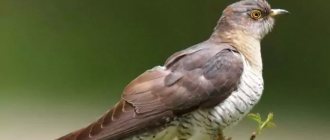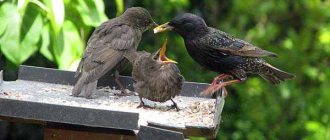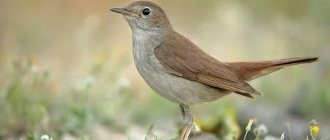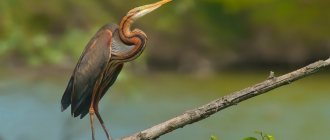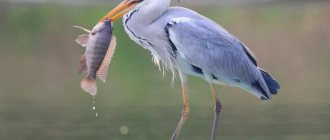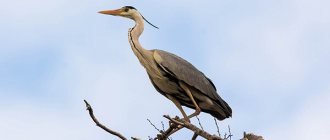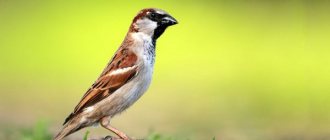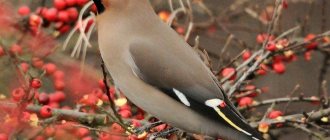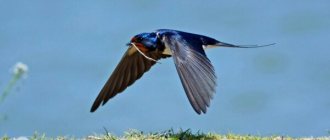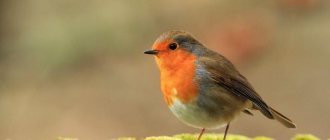The heron is a rare bird from the pelican or stork order. Everyone has heard about it at least once, but only a few have seen it. Finding a heron is not so easy; it is quite shy and hides from people. We will tell you about the most interesting species, talk about legends and signs associated with herons, and also learn everything about the reproduction and offspring of this bird.
The heron is a rare and shy bird of the heron family.
Appearance of herons
The appearance of representatives of the heron family varies greatly among individuals of different species. The largest herons reach a length of about one and a half meters, and the smallest barely grow to 40 centimeters. Weight also varies, but on average, herons weigh about 2.5–3 kilograms, although there are giants weighing 7 kilograms.
The plumage color of most herons is uniform, but the shades are different:
- white;
- ginger;
- grey;
- black.
Bicolored herons are rare. They are usually black and white.
The plumage of all herons is smooth, some species are decorated with a crest on the head.
Despite significant differences in height and weight, all herons have the same body structure. Therefore, when you see several photos of herons of different species, you will immediately understand that these are relatives.
These birds have a very long neck, which is usually in an S-shape. Herons straighten it only during hunting, so it is more convenient to capture prey.
The heron's S-shaped neck is a distinctive feature of the bird and helps it during hunting.
All herons have a long and straight beak containing sharp teeth.
The legs are very thin, but elongated. Birds move in large steps, their length can reach 0.5 m. During hunting, on the contrary, they mince in small steps (about 25 centimeters). The feet have sharp, tenacious toes.
Herons have very long, massive wings, but a small and short tail.
Despite the fact that the heron lives near bodies of water, it cannot swim or dive. The fact is that she does not have a special coccygeal gland that would secrete fat to protect the feathers from water. Therefore, water can be dangerous for birds - wet feathers are very heavy.
If you look at a photo of a heron, you will notice that in all the photographs the bird looks very well-groomed. This is not surprising - it uses its down to protect its feathers from external factors. It crumbles easily and becomes the consistency of powder or powder. It accumulates on certain areas of the body - powder areas. The heron uses it to cover its feathers. This is done using the middle finger with a long and sharp claw. The bird is ready to spend the whole day beautifying. Thanks to this powder, the bird's feathers do not stick together, despite the fish oil and mucus constantly flowing down the chest.
Often the heron is confused with cranes or storks. They are indeed a little similar in appearance, but if you look closely, they are easy to distinguish from each other.
Differences between a heron and a stork:
- The stork has a straight neck, and the heron has a curved neck;
- stork is a larger bird;
- storks do not have powder, so they look disheveled and sloppy;
- The stork is most often white.
Differences between a crane and a heron:
- cranes are much more massive than herons, their weight can reach 11 kilograms;
- Cranes have a bushier tail and a smaller beak;
- The crane's legs are longer than those of the heron.
There are many differences between the heron, crane and stork both in appearance and in behavior and lifestyle
How long do herons live?
The lifespan of herons does not depend on their gender. The first year is the most dangerous for these birds. According to statistics, about 70% of heron cubs die before they even live a year. On average, herons live about 10–15 years, but some representatives of some species can live up to 23 years.
general characteristics
Herons are considered quite large birds, the size of which can be about 100 cm. On average, an adult can weigh up to 2 kg, with the male being somewhat heavier than the female. There are no other sexual differences between herons.
The body of the bird is dense and massive. They have a long neck, which occupies an unusual position in flight.
Unlike other storks, which stretch their neck forward during flight, the heron positions it so that the back of its head touches its back.
Herons have long legs on which there are four toes: three pointing forward, one pointing back. The wings have a rounded end, their span can reach 2 meters, which allows the birds to feel good even on long flights.
Birds have one particularly long claw, used for maintaining hygiene. Powder appears on the broken tips of feathers, which is needed to lubricate the feathers. This prevents them from sticking together due to the mucus secreted by the fish they eat. For this purpose, the longest claw is used, which helps in “dusting” the plumage.
The color of the birds is usually monochromatic; the characteristic colors are gray, white, black, and sometimes red. The color of the beak is yellow or dark brown, less often black. The plumage is quite smooth, and some varieties have a crest on the head.
Elena
Ask a Question
Question to the expert
What sounds do herons make?
The repertoire of these birds is quite wide, although for the most part herons can be called silent individuals. Most often you can hear a sound from them that is similar to a scream with a grinding sound and is reminiscent of the croaking of other birds. This sound is pronounced on the fly and can be easily heard from anywhere, even at a distance. Other sounds are quite difficult for ordinary people to hear, since herons make them during nesting. The sound range is wide and can manifest itself in the form of an alarm signal - a short cackle, an aggressive warning - a prolonged vibration reminiscent of a guttural scream. A male entering a new place makes himself known with a short, dull croak. When the birds forming a colony begin to communicate with each other, their “conversation” resembles a mixture of cawing and croaking. When landing, birds may make a sharp sound resembling a grinding sound.
Heron populations
Today, only two species of the heron family are in danger - the Madagascar (about 1,000 individuals left) and the white-bellied (there are even fewer, no more than 300). These herons are listed in the Red Book as an endangered species and a species on the verge of extinction, respectively.
But back in the century before last, the heron was almost destroyed for the sake of beauty - long feathers looked great on the hats of fashionistas of that time. Because of this, up to 2 million individuals per year were destroyed in North America and Europe alone. Because of this, more than 50 species of herons were completely exterminated.
And 50 years ago the world could have lost the gray heron. It was actively exterminated in Russia and China due to the fact that people thought that the bird was eating too much valuable commercial fish. Fortunately, the mistake was quickly cleared up and the gray heron population was not too affected. As it turned out, birds destroy only weak and sick fish, thereby clearing water bodies of them.
Photo of a heron standing on one leg
Currently, herons are mainly threatened by poachers, forest fires and anthropogenic activities, such as active road construction and drainage of swamps.
Conservation status
Today, gray heron numbers are quite high in almost all parts of its extensive range. Nowadays, in accordance with its international status, this bird is classified as a species whose existence does not cause serious concern. The total number of this species, according to the latest data, ranges from seven hundred thousand to three and a half million individuals. The most numerous populations of this bird are in Russia, Japan and China.
And just recently it was a rare species in need of protection. The gray heron in the Kirov region, for example, was listed in the regional Red Book in 2001. But already in the new edition (2011) this species was excluded from the list of protected species, since their numbers in the region had been restored.
However, in some regions of Russia the gray heron is still rare. The Red Book of Kamchatka has been replenished with this species, in accordance with the agreement between Russia, India and Japan on the protection of migratory birds.
Heron lifestyle
Most often, herons live in entire flocks, which can include up to 1000 individuals. But such large colonies are found on the shores of those reservoirs where fish and other aquatic life are found in great abundance (most often in European countries). Basically, herons create colonies of 15–100 birds, and some species, for example, the Goliath heron, even prefer to live separately from everyone else, avoiding any proximity with relatives. Heron nests are located at a considerable distance from each other, maintaining distance. They do not form dense flocks.
During the day and at dusk, herons hunt, and at night they prefer to sleep closer to each other so that, if necessary, they can jointly defend themselves from enemies.
THIS IS INTERESTING. Colonies are often inhabited by herons of various species and even representatives of other families of birds - golden eagles, rooks, cormorants.
How does a heron fly
A heron in flight is a beautiful and unusual sight. It flies rather slowly and ponderously, which distinguishes it from storks or cranes, which are famous for their grace. If you look at a photo of a heron in flight, you will notice that the bird looks a little humpbacked.
In order to take off, it makes short and sharp wing beats, which become smoother after gaining the required height.
Photo of a heron in flight
The heron is capable of picking up speed up to 50 km/h in case of danger. Then its measured wing flapping changes to rapid and chaotic ones.
Breeding offspring
In the nest, females lay from three to seven eggs, which are then incubated for 27-28 days. The chicks hatch with sight, and after a week they are covered with grayish down.
Without their parents, they are virtually helpless - to survive they need to be provided with quality food, and this is very difficult to do. Therefore, from the entire brood, as a rule, from 1 to 3 chicks survive.
Young birds begin to fly independently and find food for themselves after about 50 days. The offspring remains close to their parents, continuing to participate in the general life of the pack.
Where does the heron live?
These birds can be found on almost all continents, with the exception of cold Antarctica and areas covered with ice.
Birds live on continents, peninsulas and islands. Their range depends on the species. For example, the gray heron is found almost everywhere in Eurasia and Africa, while the Madagascar heron lives only in Madagascar.
In Russia, herons live in almost all regions, with the exception of the polar ones. There are several species of herons in Siberia:
- gray;
- white-winged;
- white large.
Herons in Belarus:
- gray;
- redhead;
- white large.
Despite the fact that the heron is a wading bird, it can also settle near other bodies of water, but preferably with shallow depth. There are practically no herons on the seashore or ocean shore.
Herons prefer to settle in swampy areas
Heron - wintering or migratory bird
It all depends on where the heron lives. If in subtropical latitudes, then it does not fly away for the winter, but lives in the same place all the time.
From temperate latitudes, herons prefer to fly to warm regions around September-October. They fly at night, at high altitude. They stop to rest early in the morning. Those that live in North America go to South or Central America for the winter. Inhabiting the temperate latitudes of Eurasia - Europe (Greece, Italy), Africa (territories south of the Sahara), China, Japan, India. Herons fly to the winter in small flocks, but sometimes gather in groups of about 100–200 individuals. They almost never fly alone.
A flock of herons flies to warmer regions for the winter
The birds return back in the spring; the month of return depends on the habitat.
Habitat
Now let’s find out where the gray heron lives. This species is distributed in Asia and Europe: from the shores of the Atlantic Ocean, the Japanese Islands and to Sakhalin, in the south to Sri Lanka and North-West Africa, in the north to Yakutsk and St. Petersburg. Usually breeds in Madagascar. Winters in many regions of India, Indochina and Africa.
Probably, many of our readers well remember Nikita Mikhalkov’s soulful performance of the song in the film “Cruel Romance”, which contains the following lines:
“The furry bumblebee is for fragrant hops,
Gray heron - in the reeds..."
Indeed, in many regions, the heron of this species prefers to build nests in the reeds, for example in Turkmenistan. In addition, their nests can be seen in trees.
Natural enemies of herons in the wild
Some species of herons are quite large in size, so they have practically no enemies among birds. Smaller species are threatened by birds of prey such as falcons, hawks, eagle or kites.
During the hunt, herons are often attacked by crocodiles (if, of course, they are found in a reservoir).
The eggs of herons are much more often endangered. Bird nests are often destroyed by martens, foxes, and wild cats.
The charming animal marten often destroys heron nests
Natural enemies
Depending on the region of residence, local predators pose a threat to the heron. Especially aquatic ones, like crocodiles, in those latitudes where they live nearby. Smaller species are attacked by larger species of eagles, falcons and owls.
Photo: erbirds.ru
Oriole (50 photos): description of the bird, habitat and what it eats
How do herons reproduce and what kind of offspring do they produce?
Male herons are not very different from females. Except that they are a little larger, and the males of some species also have tufts of black feathers on the back of their heads.
Herons are monogamous birds, but all their “love and fidelity” exists only once a year during the mating season, which begins around May-April. After its end, the couple breaks up, the birds fly away for the winter and most often do not see each other again. But there are exceptions when birds live together for several years.
The fact that herons are ready to begin breeding is signaled by the changing color of the skin around the eyes and the shade of the beak. The males of some heron species grow long feathers on their backs. They are called aigrette.
During the courtship period, the male demonstrates all his beauty - he shows his crest and feathers, crouches, and cracks his beak. However, females must remain cool - if you approach the male too quickly, he will reject the potential bride. “Marriage” is concluded with the most patient female, who has not approached the male for the longest time. And it’s not a matter of decency, it’s just that the male and female look almost the same, and the first one needs time to make sure that this is really his beloved and not a cunning competitor.
Both participate in the construction of the nest - the male brings material, and the female builds a house from it for future chicks. Sometimes they find last year's nest, and if it is not destroyed, they lay eggs there. Nests are mainly built from dry branches and grass.
Herons usually build nests on tree branches
THIS IS INTERESTING. Nests are built on trees and bushes. Moreover, if there are nests of other birds nearby, the herons try to build theirs above them.
The female lays up to 7 blue or white eggs and immediately begins to hatch them. The chicks hatch in about a month. All this time, the female and male take turns incubating the eggs.
The chicks are not born at the same time, some a little earlier, others a few days later. Therefore, the division into weak and strong cubs in herons is especially acute. The chicks hatch without feathers, but can immediately see. Plumage begins to appear after about a week.
The chicks are fed by the female, mainly with fish. But there is not enough food for everyone, only the most arrogant and strong. Therefore, out of all the offspring, only a few chicks often survive. They also die because, while learning to move along branches, they often get stuck in them, get injured, or fall from a height.
Approximately 2 months after birth, the chicks already know how to fly and begin to get their own food.
Growing offspring of a heron
Females reach sexual maturity by two years.
Male and female gray heron: main differences
The gray heron is characterized by weak sexual dimorphism. It is difficult to distinguish between a female and a male even at close range. This can be done by comparing the sizes of birds of different sexes: if the wing length exceeds 46 cm and the beak is longer than 12 cm, then it is a male; if the wing is shorter than 44 cm and the beak is shorter than 11 cm, then it is a female.
Singing herons
They voice most often during flights, making sharp sounds that are more like a grinding or hoarse croak. On land they are rather silent birds. They prefer to “talk” only with their fellow tribesmen and do not communicate with other birds. When greeting, herons quickly click their beaks. When they are threatened with danger, and they want to warn their fellow tribesmen about it, they bend their necks and emit a guttural cackle. And if the heron, on the contrary, poses a threat itself, it begins to scream, and vibrating notes can be heard in the scream.
We invite you to watch a short video that demonstrates the singing of herons.
Types of herons and their characteristics
There are many species of herons in the world (about 60).
- Gray Heron. One of the largest representatives of the heron family, its height can reach a meter, and its average weight is about two kilograms. Most often the bird is found in Eurasia, Africa and Indonesia. The plumage is gray with black stripes, and there is a black crest on the head. The beak is yellow.
- Great White Heron. It is distinguished by its snow-white plumage and large size - the weight of an adult male is about 1 kg and the height is 1 m. It is found in warm latitudes - in Europe, New Zealand, Asia, Africa, Australia, South America. The heron is listed in the Red Book of Russia.
Photo of great egret - Little white heron. The second name is chepura-need. This is a small bird that is common in the Eastern Hemisphere. In Russia, it can be found in the European part of the country near large rivers. The plumage color is white, average weight is no more than 600 grams.
- Big blue. This is a close relative of the gray heron, but it lives in India, Central and South America, and is found on the Galapagos Islands. She was also seen on Ratmanov Island in Russia, but she ended up there, most likely, by mistake. The bird is large, its weight can reach 2.5 kilograms, and its height is 1.4 meters. The feathers are gray and there are brown and black stripes on the neck.
- Shoebill heron. It is also called the royal heron. Belongs to the shoebill family. Lives in East Africa. The peculiarity of the bird is that its eyes are located in the front, and not on the sides, like other birds. The shoebill is also easily recognized by its large beak, which closely resembles a shoe made of wood.
The beak of the shoebill heron resembles a large wooden shoe - Great heron or little bittern. This is the smallest representative of herons, whose height barely reaches 36 centimeters. The bird weighs about 150 grams. It lives in Africa, Russia and other European countries, India, Australia. The little heron is the only species of heron in which the male and female are different in color. The former have black plumage, and the latter have brown plumage.
- Heron heron. The second name is night heron. A small bird found on all continents except Australia and Antarctica. It is predominantly nocturnal and sits motionless on branches during the day.
- Giant or Goliath heron. Distributed mainly in Africa, in areas located south of the Sahara. Occasionally it can be found in Asia. Prefers to lead a sedentary lifestyle. Weighs up to 7 kilograms, height can reach one and a half meters. For such large dimensions, the bird is called a giant.
Goliath Heron - a large and beautiful bird - Medium white. A small bird with white plumage. Found mainly in Africa, South Asia and Australia. It was spotted in Russia in the Far East.
- White-necked. The second name is Pacific heron. Most representatives of the species live in Australia, but these herons are also found on the island of Tasmania, New Zealand and New Guinea. It is a large bird with black or gray feathers on its body. The neck and head are white.
- Black-necked. Lives in South Africa and Madagascar. Externally, it is very similar to the gray heron, only with a darker color. Short in stature, about 70–80 centimeters.
- South American. Most individuals live throughout South America. Some specimens may fly to the Falkland Islands and Trinidad and Tobago. A large bird weighing up to 2.5 kilograms and more than a meter tall. The plumage is gray, the legs are pink. The head and neck are white, with a black crest.
- Madagascar. This is a rare bird found exclusively in Madagascar. It is listed in the IUCN (International Union for Conservation of Nature) Red List as an endangered species. The heron is small in size, up to about 90 centimeters. Feather color is gray.
A rare species of heron - Madagascar - Redhead. It is found mainly in reeds. Found in European countries, southern Asia and Africa. The color is dim, for easy camouflage. The plumage is red and gray. Very long fingers with sharp claws.
- White-winged. A small bird living in South and East Asia. Individual representatives can be found in Mediterranean countries and in the Primorsky Territory. The bird is very beautiful, especially during the mating season - the head and neck are reddish, the back is gray, and the sides and lower part are white. The height of a heron is no more than half a meter.
- White-bellied. The rarest heron, which is found only in the foothills of the Himalayas in Bhutan, India and Myanmar. Previously nested in Bangladesh and Nepal, but no longer occurs there. Several hundred individuals remain. A large bird, second in size only to gigantic herons. The plumage is mostly gray. Many efforts are being made to protect it; it lives in national parks and reserves. In 2011, the white-bellied heron appeared in captivity for the first time. She was released into the wild after being equipped with a sensor to track her movements.
- Egyptian. One of the most numerous representatives of the heron family, inhabiting almost the entire planet, except for cold areas covered with ice. The bird has a dense, massive body, a relatively short neck and beak. The color of the feathers is white; during the mating season they turn bright colors - orange, yellow, golden.
What does a heron eat?
The heron is a predator that feeds on almost all living creatures that it can handle. The heron mainly eats aquatic and semi-aquatic inhabitants:
- fish;
- toads and frogs;
- snakes and lizards;
- newts;
- crayfish;
- insects;
- chicks and small birds;
- baby rabbits and even small rabbits.
The basis of the heron's diet is fish and amphibians
. The gigantic heron, whose weight can reach 5 kilograms, even feeds on monitor lizards or mamba. Most often, herons hunt in water, at shallow depths. They move through shallow water, carefully looking for prey. They often freeze in one place, moving their fingers to lure fish and other aquatic inhabitants closer to them.
To hunt ground animals, herons choose a wait-and-see tactic, sitting for a long time in trees and bushes.
Some species of the heron family, such as the Egyptian heron, stay close to large animals (buffalo or elephant) to catch insects that they frighten.
The great egret often hunts with its fellow birds, while taking food from smaller birds.
Nutrition
The diet of the gray heron consists only of animal food. This is an active, dexterous and extremely voracious predator. Its prey is any land or aquatic animal that the heron can physically cope with. But since these birds spend most of their lives near bodies of water, it is not difficult to guess what the gray heron eats.
The dominant position in their diet is occupied by fish, no longer than twenty-five centimeters and weighing no more than five hundred grams. The gray heron will not refuse frogs, various insects, crustaceans, and mollusks. On land, these are usually lizards and small rodents, snakes, large grasshoppers, beetles and locusts.
Interesting facts about the heron
A lot of interesting things can be said about this unusual bird.
- Many have noticed that the heron often stands in the water on one leg. This is due to the fact that the water is most often very cold. Therefore, the heron simply warms one leg while the other is cold. A bird can stand on one leg for several hours. In addition, it is easier to hunt this way - the fish mistake their legs for reeds and swim close to the predator.
A heron stands on one leg because of the cold water - The heron's eggs are of an unusual shape - they are pointed at both ends, and not at one, like most birds.
- Despite the fact that the average age of herons is 10–15 years, one of them managed to live as long as 25 years.
- The heron always swallows the fish head first, otherwise it may injure the esophagus.
- Herons are shy birds that prefer to stay away from people. However, a whole population of these birds has been living in Amsterdam for many years, and they are not at all afraid of local residents and tourists. There are a lot of fish in the local canals, but people feed the birds, and in return they joyfully pose in front of their phone screens and camera lenses. Why birds decided to settle in the capital of Holland is a mystery to all ornithologists.
Amsterdam herons calmly walk along the city streets and are not at all afraid of people - In winter, herons prefer to live near salty bodies of water, and in summer they move to fresh water.
- During migration, they can fly a distance of several thousand kilometers and rise to a height of 2000 meters.
- Herons feed exclusively on living creatures, without consuming any grass. Therefore, their own meat is not tasty, although it can be eaten.
- To attract fish, herons spread their wings wide. This creates a shadow over the water, where future prey happily swims up.
- Sometimes they hunt in groups. While some birds stir up the water, scaring the fish, others grab the prey.
Signs associated with the heron
There are quite a lot of signs and beliefs associated with this unusual bird. People believe that meeting a heron in its natural habitat means that you will soon meet a person with whom you will have a serious conflict, which may escalate into a fight. This sign appeared due to the fact that herons are real aggressors who do not hesitate to drive other birds out of their nests.
If herons drive birds out of their homes on your summer cottage, this means that the family will soon have worries and worries.
THIS IS INTERESTING. The egret is an exception to the rule. Seeing this majestic bird is a good sign. It is believed that a person can see it only once in his life. Although there are lucky ones who meet the bird several times. Finding the feathers of a white heron is good luck.
Seeing a white heron is a good omen
Herons can also predict weather conditions better than any meteorologist. If you need to know what the weather will be like, watch the birds carefully. When they are high in the sky, rain or snow should be expected. And their ringing cries, on the contrary, promise clear, warm weather. You can also learn about cold weather by looking at the direction of flight of herons. If you see them flying north, expect warm weather. When flying south, take out warm clothes, it is getting colder.
Herons should never be killed. And it's not even a matter of humanity. People believe that killing these birds threatens misfortunes and misfortunes.
Why do you dream about a heron?
Most often it is believed that seeing a heron in a dream is good news. The white heron dreams that soon all your affairs and projects will go uphill, and all your plans will come true. However, many dream books interpret the meaning of dreams depending on what the bird did in your dream:
- if she talks to you, you will soon communicate with an intelligent and influential person;
- eats or catches frogs - in your social circle there is a person who likes to collect gossip;
- a heron standing on one leg symbolizes your inner insecurity;
- a sleeping bird dreams of rain;
- gets dirty in the mud - your future actions have some not entirely pure background.
Heron in the culture of different countries of the world
In most countries, birds are given great importance, and the heron is no exception in this regard. In China, she is considered a symbol of the feminine principle, as well as a mediator between the world of the living and the dead. There is a similar belief in Egypt. There they believe that it is the heron that first transforms the soul of the deceased into another existence. The heron is also compared to the morning sun or the Benu bird. Seeing a heron is considered a good sign. In Japanese culture, the heron is compared with the black crow, and together they form yin and yang, light and darkness, good and evil, a silent sage and a stupid talker. The Japanese also associate the bird with calmness, because it can take off so carefully that it won’t even disturb the surface of the water.
Vocal data
The repertoire of gray herons is quite diverse, although ornithologists classify these birds as silent. Most often you can hear a rough and slightly rasping cry, reminiscent of the short croak of a crow. It is usually produced by herons in flight. It can be heard over a long distance.
Gray herons make all other sounds in the colony during nesting. A short cackle is an alarm signal; a long, vibrating throat sound indicates aggression. A dull short croak means that there is a male in the flock. Birds that gather in large groups within the colony constantly “negotiate” with each other, emitting croaking and croaking calls.
Legend of the Heron
In many countries it is considered a mystical creature; it is quite logical that many legends are associated with the bird. One of them explains the appearance of these birds on Earth. Allegedly, the world's first heron originated from a disobedient man. God gave him a bag of various creeping things and told him to throw it away as far as possible. However, the man did not listen and untied the bag, causing all the snakes and reptiles to escape. As punishment, God turned man into a heron - a bird with a beak reddened with shame, whose purpose is to rid the Earth of snakes.
Interesting facts about the bird
- The gray heron has a developed system of visual signals. Thanks to its long neck, the bird expresses a variety of emotions. So, in a threat pose, the heron arches its neck, as if preparing to attack, and raises the crest on its head. This pose is accompanied by a special threatening cry. Quickly clicking their beaks, the herons greet each other. They also observe similar behavior during mating rituals.
- The meat of the gray heron is edible, sometimes obtained by hunters, but according to reviews it does not have a pleasant taste.
- In the old days, the gray heron was a favorite object of falconry.
Why is the heron called that?
The Latin name for the heron is ardea. It is believed that the word “heron” in Russian comes from the word “chapat”. The bird received this name because of its strange and awkward gait.
Herons have a funny and clumsy gait
“Chapat” is translated as “to mince, to cling to the earth.” Initially, the bird was called Chaplya (the letter “ch” at the beginning is still preserved in the Ukrainian, Bulgarian, Serbian languages). “C” appeared because of the characteristic Northern Russian clattering.
